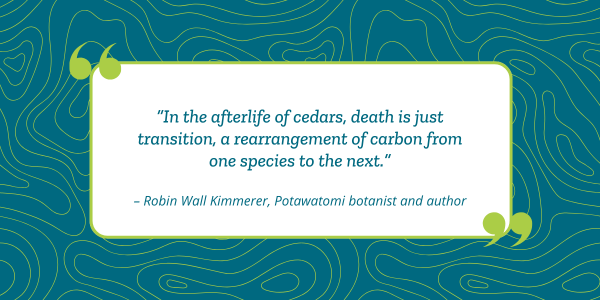|
|
|
|
|
|
|
Welcome to Your Daily Dot where Dot will share tips, advice, and stories on how we can make our world better. |
|
|
|
|
|
If you purchase anything via one of our links, including from Amazon, we may earn a small commission.
All Dear Dot illustrations by Elissa Turnbull. |
|
|
 |
|
|
|
Dear Reader,
The forest where Dot hikes each morning before work has the occasional sign tacked to a still-standing-but-obviously-dead tree, noting that the rooted carcass provides habitat for birds and bugs, even in its afterlife. Our woods, as my hiking pal and I call it, is home to many rotting logs, beaver-gnawed trunks, and, we noticed recently, batboxes nailed to trees. We have seen coyotes, snakes, and a fat raccoon that refused to cede the path to us, causing us to take a work-delaying detour. Our woods’ soundscape varies depending on the time of year. At the moment, for instance, it’s quieter than at the height of summer — some avian species have already headed south, while others will follow suit up until mid-November, and still others will wait out the winter.
In other words, our woods teems with life, even the dead parts of it. As Robin Wall Kimmerer, author of The Serviceberry, says in a beautiful essay called “Becoming Earth,” the afterlife of trees is in service to existing life, a “rearrangement of carbon” that feeds other species.
Similarly, Dot has long been fascinated by what’s called “whale falls” — when the behemoth body of a dead cetacean sinks to the ocean floor. The deeper the fall, the more intact the body remains as the scarcity of oxygen slows down decomposition. But whatever the ultimate landing spot for the whale’s body, an entire ecosystem springs up in its presence. (For some beautiful images of whales accompanying a stunning story, check out Atmos’ “After the Fall.”) The decomposition has several stages: the initial scavenging process, whereby hagfish and various other marine creatures consume the soft tissue; an enrichment-opportunist phase, during which small and micro-organisms arrive to feed on much of what’s left; and the third and final sulfophilic stage, during which bacteria break down the whale’s oil-rich skeleton, supporting more marine creatures for years. Indeed, “Researchers have discovered up to 190 different species inhabiting whale falls at this final stage — some of which have been found nowhere else in the world,” the University of Texas Marine Science Institute tells us.
As we ponder the life that these dead things support, let’s lament the tree that won’t enjoy an afterlife of feeding other species thanks to the chop heard round the world, when two men in the U.K felled a beloved sycamore that admirers likened to “an old friend.” The chainsaw-wielding tree murderers filmed themselves, their second error in judgement, and one that helped convict them for the crime. But all is not lost. As The Guardian reports, “The tree is gone, and for a long time it looked like that would be that. Then last summer something remarkable happened: fragile green shoots were spotted emerging from the tree’s stump.”
Serviceably,
Dot
|
|
|
|
|
 |
|
Make sustainable living simple with the Bluedot Living’s Green Home Deluxe Kit — a $170+ value collection of our editors’ favorite Earth-friendly products, free with your membership. You’ll also enjoy exclusive member savings, inspiring community connections, and more planet-positive perks. |
| Get Your Deluxe Kit |
|
|
|
|
|
|
|
|
|
|
|
|
|
|
|
|
|
|
|
|
|
|